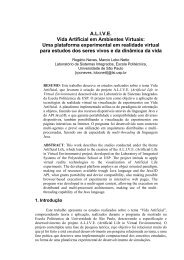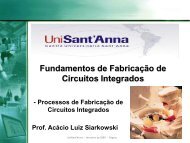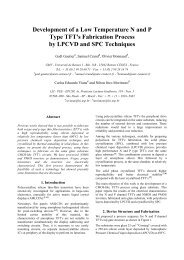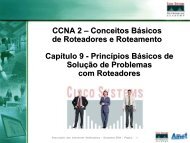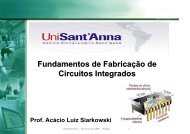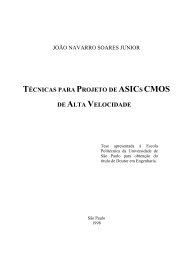Contactless Determination of Minority-Carrier Lifetimes ... - LSI - USP
Contactless Determination of Minority-Carrier Lifetimes ... - LSI - USP
Contactless Determination of Minority-Carrier Lifetimes ... - LSI - USP
You also want an ePaper? Increase the reach of your titles
YUMPU automatically turns print PDFs into web optimized ePapers that Google loves.
<strong>Contactless</strong> <strong>Determination</strong> <strong>of</strong> <strong>Minority</strong>-<strong>Carrier</strong><strong>Lifetimes</strong> by Photoconductance MeasurementsCarlos A. S. Ramos a) and Manuel Cid SánchezLaboratório de Microeletrônica - Departamento de Engenharia de Sistemas Eletrônicos - PSIEscola Politécnica da Universidade de São Paulo. P.O. Box. 61548Zip Code 05424-970, São Paulo/SP, Brazil.a)cramos@lme.usp.br, mcid@lme.usp.br.AbstractLifetime measurements <strong>of</strong> minority carriers in siliconwafers are extremely useful for process control anddevice optimization as well as for the study <strong>of</strong> physicalproperties <strong>of</strong> the material. The use <strong>of</strong> the WCT-100lifetime tester apparatus, described here, allows a fastand easy to use method to determine the sampleparameters, without the need <strong>of</strong> complex electronics andlight sources, being capable to measure lifetimes in thenanosecond to millisecond range.Also, it is possible to investigate the injection leveldependence <strong>of</strong> the lifetime over a wide range <strong>of</strong> lightintensities, from 0 to 1000 suns, simply varying theposition <strong>of</strong> the source relative to sample. This allowstheoretical fittings <strong>of</strong> the obtained results, in order toextract parameters such as energy and density <strong>of</strong> defectsin the gap.1. Introduction<strong>Contactless</strong> measurements <strong>of</strong> minority carrier lifetimes, anon destructive method obtained by means <strong>of</strong> quasisteady-statephotoconductance (QSSPC) data [1] [2] [3],has been widely used in investigations <strong>of</strong> materialproperties and process control.The WCT-100 uses a coil to inductively couple thesample signal to an digital oscilloscope and amicrocomputer for data analyses and storage (figure 1).The QSSPC technique measures the photoconductance<strong>of</strong> a sample subjected to a relatively long (~2ms – steadyor quasi-steady-state illumination) light pulse, generatedby a flash lamp, an array <strong>of</strong> light-emitting diodes (LEDs)or another source.Under this condition, the photogenerated excess carrierdensity, ∆n=∆p, results in an increase in waferconductance given by:∆ σL= ( µ n ∆n+ µ p ∆p)qW= q∆n(µ n + µ p )W (1)where W is the wafer width, µ n and µ p are the carriersmobilities.Also, the generation and the recombination rates must bebalanced, leading us to:Jphotogeneration=Jrecombination (2)In terms <strong>of</strong> effective minority carrier lifetime we have:J ph =q∆nW/τ eff (3)Combining equations (2) and (3), we can obtain anexpression for determining the effective lifetime <strong>of</strong> theminority carriers:τ eff =σ L /[J ph (µ n +µ p )] (4)In the WCT-100 the conductance is measured through acalibrated RF bridge, after zeroing the signal <strong>of</strong> thewafer over the inductive coil, and the light intensity bymeans <strong>of</strong> a reference solar cell, located near the sample.Inductive CouplingRFFlash LampSample WaferCRMicrocomputerOsciloscopeFig. 1: WCT-100 sample signal acquisition scheme.Since the RF bridge circuit, operating in a frequency <strong>of</strong>8-10Mz, is well designed, the output voltage and thewafer sheet conductance follow a linear relationship, in arange that depends on the circuit topology (in our casefrom 0.02S to 0.3S). The variable resistor/capacitor areused to balance the bridge to zero, prior to themeasurements.The value <strong>of</strong> J ph measured by the reference solar cellshould also be modified, taking in mind the conditions <strong>of</strong>our particular sample like thickness, reflectivity or lighttrapping features. Even considering all these cases, thephotogeneration in the sample should lie in a thigh rangebetween 0.8-1.1 <strong>of</strong> that measured by the reference [4].In this way, the effective lifetime is measured at everylight intensity, following the procedures and equationsoutlined above.In order to obtain a more accurate value <strong>of</strong> the minoritycarrier lifetime it is necessary to separate the bulkcontribution from the surface effects, by means <strong>of</strong> a
Sample ρ bulk(Ωcm)Thickness(µm)τ eff(µs)FZ50-B 50.0 300 3672FZ 0.47 350 99FZ 0.90 402 275CZ 1.40 345 255Table 2: Effective lifetime for samples subjected to a lightphosphorous diffusion step at ∆n=10 14 cm -3 .Roughly, we can use the direct measurement <strong>of</strong> theeffective lifetime at a specified carrier density todetermine the degradation <strong>of</strong> a wafer after eachfabrication process. From the data <strong>of</strong> table 1 and 2 it canbe observed, that the effective lifetime measured forwafers subjected to a different processes, does not showa significant dispersion.As explained above, the value <strong>of</strong> J 0 , obtained from thefitting in the graph <strong>of</strong> figure 4, imposes some limits inthe measurable lifetime depending on the resistivity <strong>of</strong>the wafer, with the higher doping densities placing amore stringent limit.This limit (τ eff→lim =qni 2 W/J 0 N A ) is showed in the table 3,with the experimental lifetimes measured from the figuregraph <strong>of</strong> the figure 3.Using qni 2 =11.75C/cm 6 and J 0 =3.6x10 -14 A/cm 2 , wehave:Sample ρ bulk(Ωcm)τ eff →∆n=10 14 cm -3(µs)τ eff →J 0 lim.(µs)FZ50-B 50.0 3672 18268FZ 0.47 99 164FZ 0.90 275 338CZ 1.40 255 548Table 3: Experimental measurements and expected limitsto the measurable lifetime imposed by emitterrecombination.By the results presented, we see that the effectivelifetime measured for the high resistivity sample can beinterpreted as a true reflection <strong>of</strong> τ bulk . The surface is nota limiting factor for determining his value.In the other way, since the contribution due to J 0 is in thesame order as the measured τ eff for the other samples, theevaluation <strong>of</strong> τ bulk becomes impossible. A betterpassivation (J 0 bellow 10 -14 A/cm 2 ) would be required fora direct measurement on these samples [8] [10].3. ConclusionsIt was presented a powerful method to examine the bulkand surface conditions <strong>of</strong> samples subjected to adifferent processes.By means <strong>of</strong> photoconductance measurements, it ispossible to study various mechanisms present in asemiconductor and their characteristic parameters, suchas bulk lifetime, surface recombination and emitterrecombination current in a wide range <strong>of</strong> injection levelconditions.Specific experiments can be prepared in order toinvestigate any phenomena <strong>of</strong> interest, and the results arefast and easily handled or fitted by any modelinvestigated.The QSSPC has also a numerous applications forprocess monitoring during solar cell fabrication, sincethe substrate and passivation quality can be evaluated forindividual fabrication steps, beginning with the initialmaterial quality, without the necessity <strong>of</strong> metalliccontacts.This method is simple and the data have a clear physicalinterpretation, being capable to measure high to very lowlifetimes with the same apparatus.Not presented here, but <strong>of</strong> great interest, is the possibility<strong>of</strong> predicting the open circuit voltage (V oc ) <strong>of</strong> solar cellsprecursors, for each step <strong>of</strong> processing.As additional advantages we can say:- The light source is inexpensive, since has no specialrequirements for short duration or sharp cut-<strong>of</strong>f;- Even measuring lifetimes less than 1µs, the dataacquired is from a 2.3ms decaying waveform,eliminating the fast electronics required for a transientdecay measurement;- The result depends upon the absolute value <strong>of</strong> a smallsignal, rather than its derivative;- Ranging the applicability, it is effectively a steady-statemeasurement, similar to the cell in actual operation.3. AcknowledgmentsThis work was supported by FAPESP, under contract n o95/09435-0 and by Rhae/CNPq under contract n o610157/94.References:[1] Ronald A. Sinton, Andrés Cuevas; Appl. Phys. Lett. 69(17), 21 October 1996, p. 2510.[2] Andrés Cuevas, Ronald A. Sinton; Prog. in Photovoltaics:Research and Applications, Vol. 5, (1997).[3] Jan Schmidt, Andrés Cuevas; Journal <strong>of</strong> Applied Physics,Vol. 86, n o 6, September 1999, p. 3175.[4] User Manual - WCT-100 Photoconductance Tool – revisedversion 1998 – Sinton Consulting 1132, Green CircleBoulder , CO 80303.[5] E. Yablanovitch, et. al.; Physical Review Letters, Vol. 57,n o 2 – July 1986, p. 249.[6] Richard R. King et. al.; 22 nd IEEE Photovoltaic SpecialistsConference, Las Vegas, NV, October, 1991.[7] Andrés Cuevas; Solar Energy Materials and Solar Cells,Vol. 57 (1999), p. 277.[8] D. E. Kane, R. M. Swanson; 18 th IEEE PhotovoltaicSpecialists Conference, Las Vegas, NV, October, 1985.[9] D. Macdonald, Andrés Cuevas; Applied Physics Letters,Vol. 74, n o 12, March 1999, p. 1710.[10] Andrés Cuevas et. al.; IEEE Transactions on ElectronDevices, vol. 46, n o 10, October 1999, p. 2026.[11] Dieter K. Schroder; Semiconductor Material and DeviceCharacterization, “A Wiley-Interscience publication” ,ISBN 0-471-51104-8, 1990, pp.359-447.




